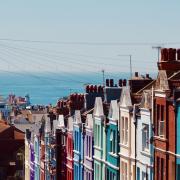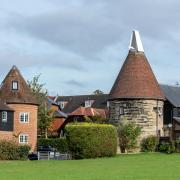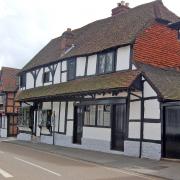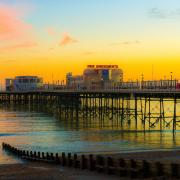As Gatwick Airport undertook a consultation exercise to turn its emergency strip into a long-awaited second runway, we speak to the Sussex residents leading the campaign against expansion
Sally Pavey’s quality of life took a plunge five years ago when the roar of soaring jets above her home announced the arrival of a new flight path from Gatwick Airport. A marketing consultant, Sally lives with her husband, two children, dogs and hens in a converted farmhouse near Horsham in a village that is full of English rural charm, on the ground at least.
Today, though, she says the village is blighted by aircraft noise. “It’s horrendous, even with double glazing and thick curtains. We live in what should be a tranquil area but the noise from aircraft makes you angry because it’s 24/seven and you can’t do anything to stop it.”
Gatwick has permission to operate limited flights throughout the night – which might sound disturbing enough – but the worst time for Sally is early in the morning. When 6am comes, it is no longer defined as night-time and Gatwick packs in as many flights as it can.
“It’s a big, noisy start, although Cathay Pacific comes in before that at 5am. It’s the same in the run-up to 11.30pm – there’s a surge of activity before the official start of night-time cuts movements down.”
And now Sally – who is also chair of Communities Against Gatwick Noise Emission (CAGNE) – fears things could get worse. In October Gatwick Airport set out its vision for the years ahead and it is one based on expansion. In particular, the airport is currently carrying out a public consultation on the idea of turning its little-used emergency runway into a full-time working one by the mid-2020s. It is a plan that has attracted anger from local communities, not least because when planning permission was granted for the emergency runway, a legal agreement limited its use to more or less just that. But that condition is set to expire in 2019 and West Sussex County Council says it “would not be feasible” for such an agreement to be repeated.
Gatwick is the UK’s second busiest airport, after Heathrow. In the year 2017/18, it handled 45.7 million passengers, 12 million more than five years before. Cargo adding up to 102,000 tonnes was also carried, a 24 per cent increase on the previous year. In all this amounted to a total of 282,000 aircraft passing through. Gatwick could certainly be described as a success story and the airport says it contributes £5.3bn to the UK economy and supports 85,000 jobs, 24,000 at the airport itself.
The Gatwick Airport Draft Master Plan 2018 would suggest though that this is not enough. With a twin-runway operation and improved operating procedures, the airport predicts a passenger throughput of 68-70 million passengers by 2032/33, an increase of up to 53 per cent from 2017/18.
Gatwick makes the point that bringing its standby runway into routine use is consistent with Government policy that urges best use of existing runway infrastructure. It also argues that development of Gatwick would bring significant benefits to the region in terms of the economy and jobs. The airport had been hoping to be ‘awarded’ an extra runway before Government opted last June to allocate it to Heathrow instead.

There is also a call by Gatwick for land to be safeguarded for a possible brand new third runway to the south of the airport, which could take capacity to 95 million passengers. Sally suspects this is Gatwick’s preferred end-game but bringing even just the emergency runway into full use would, she estimates, add 85,000 flights a year, most of them taking off to the west and potentially over villages like hers. But it is not just the noise she is concerned about. She is worried about air quality too, although the airport says it is confident that locally it would remain within safe limits.
But there is a longer term issue that also frightens Sally. “If the airport grows, we can expect demand for more infrastructure to service the airport and more people to be sucked into the area. This is going to put pressure on our green space and contribute further to the urbanisation of the countryside around this part of Sussex.”
Peter Barclay is chair of the Gatwick Area Conservation Campaign and he endorses Sally’s concerns. Living just one mile from the western end of the main runway, he is perfectly placed to have his say. “I accept that ultimately I chose to live here,” he says. “But things have got a lot worse since I moved in.
“We’re already suffering from airport-generated road traffic. Growth in traffic has run in parallel with growth of the airport.” In fact, Gatwick reveals there are more than 66,000 parking spaces associated with the airport’s use and another 9,500 are planned over the next five years.
A Gatwick Airport spokesperson says: “The Draft Master Plan contains detailed information on how the infrastructure around Gatwick will continue to improve to support our growth. Rail capacity has doubled recently and the new smart motorway lane on the M23 will increase motorway capacity significantly, in addition to some upgrades to some local roads.”
Peter echoes what Sally says about noise: “Aircraft come in and take off on very concentrated lines. At peak times, people under flight paths can get up to one a minute for a burst of ten to 12 minutes. Plane movements could go up by 30 per cent if the spare runway comes on-stream.
“All these planes have got to fly over someone.”
The airport argues: “In terms of noise, the impact of our incremental growth will be broadly in line with what it is today and will in some cases be reduced.

“This is in large part due to the ‘new generation’ aircraft which are already coming into service.”
Peter counters: “The airport’s argument is that planes are getting quieter but I’d say the difference is barely discernible to the human ear.”
Perhaps understandably, the existing flight paths tend to avoid towns such as Crawley and Horsham but Sally says that is not fair on people who have chosen to live in the country. “Rural areas are bearing the brunt. Base noise is lower in the countryside, so we really notice aircraft noise. We bought into the rural, tranquil life and now find ourselves targeted.”
Gatwick is dominated by the low-cost holiday market – easyJet, Thomas Cook and Ryanair all fly from here. Many passengers might be heading off for a well-earned holiday in southern Europe, so who should be put first – holiday-makers setting off for the sun or those left feeling the impact? One thing is clear, more people are flying and they are flying more often. According to the airport’s Master Plan: “Demand for air travel is expected to virtually double in 30 years. Even with a third runway at Heathrow, there is insufficient airport capacity to meet the unconstrained demand for UK air travel by 2050.”
But cheap foreign holidays by air bring more than just sun-tans and souvenir sombreros. They come with a big carbon emission price tag. Aviation is the most carbon-intensive form of transport and one of the fastest growing sources of carbon emissions. Sarah Clayton is co-ordinator of AirportWatch, which represents many of the key players in the environmental movement, including the Aviation Environment Federation, the Campaign for Better Transport, the Campaign to Protect Rural England, Friends of the Earth, Greenpeace and WWF UK. She says: “UK aviation is already above its carbon targets. Adding extra runways and extra capacity means aviation is going to produce way too much carbon.”
Gatwick’s own figures do not paint a rosy picture. Emissions relating to airport activities were 771,842 tonnes of carbon dioxide in 2017. Bringing the emergency runway into use could see them rise to 949,479 tonnes by 2028, an increase of 23 per cent. Last October the Intergovernmental Panel on Climate Change released a devastating report saying global warming must be kept to within 1.5°C and we are dangerously off-track from that, heading instead towards 3°C, threatening the very liveability of the planet – its ability to continue as our life support system. The IPCC insists we reduce carbon emissions by 45 per cent (based on 2010 levels) by 2030 and reduce them to total zero by 2050.
Gatwick claims to be a carbon-neutral airport. Through energy efficiency measures, electricity from renewable sources, a biomass boiler for cabin waste and electric vehicles for airport operations, it says its day-to-day activities are fundamentally green. It is the first airport to achieve the Carbon Trust Standard for providing zero waste to landfill.
However, there is an elephant in the room in the form of the emissions that come from aircraft taking off and landing, from passengers travelling to and from the airport and from staff commuting. Emissions from these sources dwarf what happens at the airport itself, which Gatwick freely acknowledges. This carbon is said to be ‘cancelled out’ by carbon off-setting – an argument that by investing in green energy schemes in the developing world for example, it doesn’t matter that pollution continues here. Environmentalists say this is spurious and the whole concept of cancelling out a bad by doing a good is flawed. It amounts to poking someone in the eye and then absolving yourself of all blame by making a donation to an eye hospital in Africa.
Carbon off-setting, they say, is a system invented by PR officers rather than scientists. Sarah maintains the claim that Gatwick is a carbon-neutral airport is “ridiculous”. And she says the emissions of aircraft during flight – in other words after take-off and before landing – are conveniently left out of the equation. These emissions make up the great bulk of aviation’s impact on the environment.
She dismisses claims by the aviation industry that new generation aircraft and advanced biofuels can reduce the problem.
Peter says: “The airport is doing well in terms of management of its internal emissions and wins awards for it. But every aircraft that leaves the airport has a huge impact and they have responsibility for that.”
It becomes apparent that this is not just an argument between those who want to go on holiday by plane and those, like Sally and her family, whose quality of life is reduced as a result. The possible expansion of Gatwick Airport is also, many would say, a battle between the juggernaut of jobs and economy on the one hand and protecting our collective future on the other. Some say aviation will take us to new heights; others argue it will play a part in bringing us all down.
More…
• 5 great walks in Sussex with pubs along the way - Stretch your legs before Sunday lunch. We suggest five great pub walks across Sussex



























